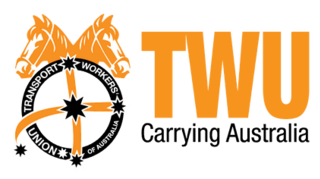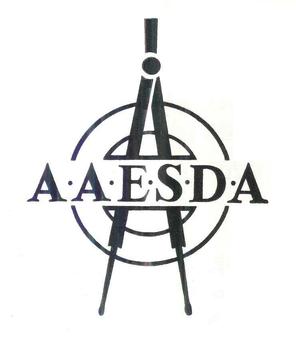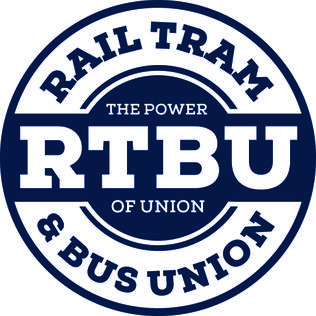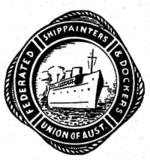
A dockworker is a waterfront manual laborer who is involved in loading and unloading ships.
The Australian labour movement began in the early 19th century and since the late 19th century has included industrial and political wings. Trade unions in Australia may be organised on the basis of craft unionism, general unionism, or industrial unionism. Almost all unions in Australia are affiliated with the Australian Council of Trade Unions (ACTU), many of which have undergone a significant process of amalgamations, especially in the late 1980s and early 1990s. The leadership and membership of unions hold and have at other times held a wide range of political views, including socialist, democratic and right-wing views.
The Australian Workers' Union (AWU) is one of Australia's largest and oldest trade unions. It traces its origins to unions founded in the pastoral and mining industries in the late 1880s and it currently has approximately 80,000 members. It has exercised an outsized influence on the Australian Trade Union movement and on the Australian Labor Party throughout its history.
The Sydney Twelve were members of the Industrial Workers of the World arrested on 23 September 1916 in Sydney, Australia, and charged with treason under the Crimes Act 1900 (NSW) which incorporated the Treason Felony Act 1848 (Imp). They were John Hamilton, Peter Larkin, Joseph Fagin, William Teen, Donald Grant, Benjamin King, Thomas Glynn, Donald McPherson, Thomas Moore, Charles Reeve, William Beattie, and Bob Besant. The treason charges were dropped prior to trial and replaced with three conspiracy charges: (1) conspiracy to commit arson (2) conspiracy to procure the release of Tom Barker from gaol by unlawful means and (3) conspiracy to excite sedition.

The Maritime Union of Australia (MUA) was a union which covered waterside workers, seafarers, port workers, professional divers, and office workers associated with Australian ports. The MUA was formed in 1993 with merger of the Seamen's Union of Australia and the Waterside Workers' Federation of Australia.

The Transport Workers' Union of Australia (TWU) is a trade union with members throughout Australia. It has 5 main branches based in: Australian Capital Territory/New South Wales; Queensland; Victoria/Tasmania; South Australia/Northern Territory; and Western Australia.

The 1929 Timber Workers strike was a labour dispute in Australia caused by Justice Lukin of the Arbitration Court handing down an industrial award decision on 23 December 1928 to reduce the wages and increase the hours for 20,000 timber workers from a 44-hour week to a 48-hour week. It was the first strike in Australia after the onset of the Great Depression.

The Royal Oak Hotel is a pub located in Balmain, a suburb in the inner west region of Sydney, in the state of New South Wales, Australia. The pub has historical links with the union movement and is one of a number of buildings which formed an integral part of the shipbuilding and industrial history of the local area.

Mort's Dock is a former dry dock, slipway, and shipyard in Balmain, New South Wales, Australia. It was the first dry dock in Australia, opening for business in 1855 and closing more than a century later in 1959. The site is now parkland.
Nick Origlass was an Australian Trotskyist who served as mayor of Leichhardt in Sydney.
The National Amalgamated Union of Labour (NAUL) was a general union in the United Kingdom.
Federated Marine Stewards and Pantrymen's Association of Australasia was an Australian trade union established in 1884, and existing as a federal union from 1909 to 1988. The association represented marine stewards and stewardesses, marine pantrymen and crew attendants. The union operated a closed shop, with all workers employed in the industry members of the union, and operated on a 'no OK card - no job' principle.
Ernest Thornton was a British-born Australian trade union leader.

The Federated Ironworkers' Association of Australia (FIA) was an Australian trade union which existed between 1911 and 1991. It represented labourers and semi-skilled workers employed in the steel industry and ironworking, and later also the chemical industry.

The Association of Draughting Supervisory and Technical Employees (ADSTE), originally known as the Association of Architects, Engineers, Surveyors and Draughtsmen of Australia (AAESDA), was an Australian trade union which existed between 1915 and 1991. It represented white collar and technical-grade employees in both the private sector and the public service.

The Rail, Tram and Bus Union Victorian Branch or RTBU Victoria is the state branch of the RTBU in Victoria. Originally formed in 1993 as the Victorian branch of the Public Transport Union and renamed the RTBU in 1998, the RTBU Victoria today represents nearly 8000 members across Rail Operations, Tramways, Locomotive, Infrastructure and Administrative areas of Victoria's public transport industry.
The Federated Shipwrights' and Ship Constructors' Association of Australia was an Australian trade union which existed between 1916 and 1976. It represented shipwrights and boatbuilders in the shipbuilding and ship repair industries, as well as sea-going shipwrights aboard vessels in the merchant navy.
The Federated Moulders' (Metals) Union of Australia (FMMUA) was an Australian trade union which existed between 1899 and 1983. It represented moulders – skilled tradesmen who fabricated the moulds for casting metal products in foundries. In spite of only organising within a single skilled occupation, which kept total membership low, the vital position of moulders in major industries such as mining, manufacturing and the railways, ensured that the union remained industrially powerful with a reputation for being highly militant.

The Waterside Workers' Federation of Australia (WWF) was an Australian trade union that existed from 1902 to 1993. After a period of negotiations between other Australian maritime unions, it was federated in 1902 and first federally registered in 1907; its first general president was Billy Hughes.
Robert Mahony was an Irish-born Australian politician.











